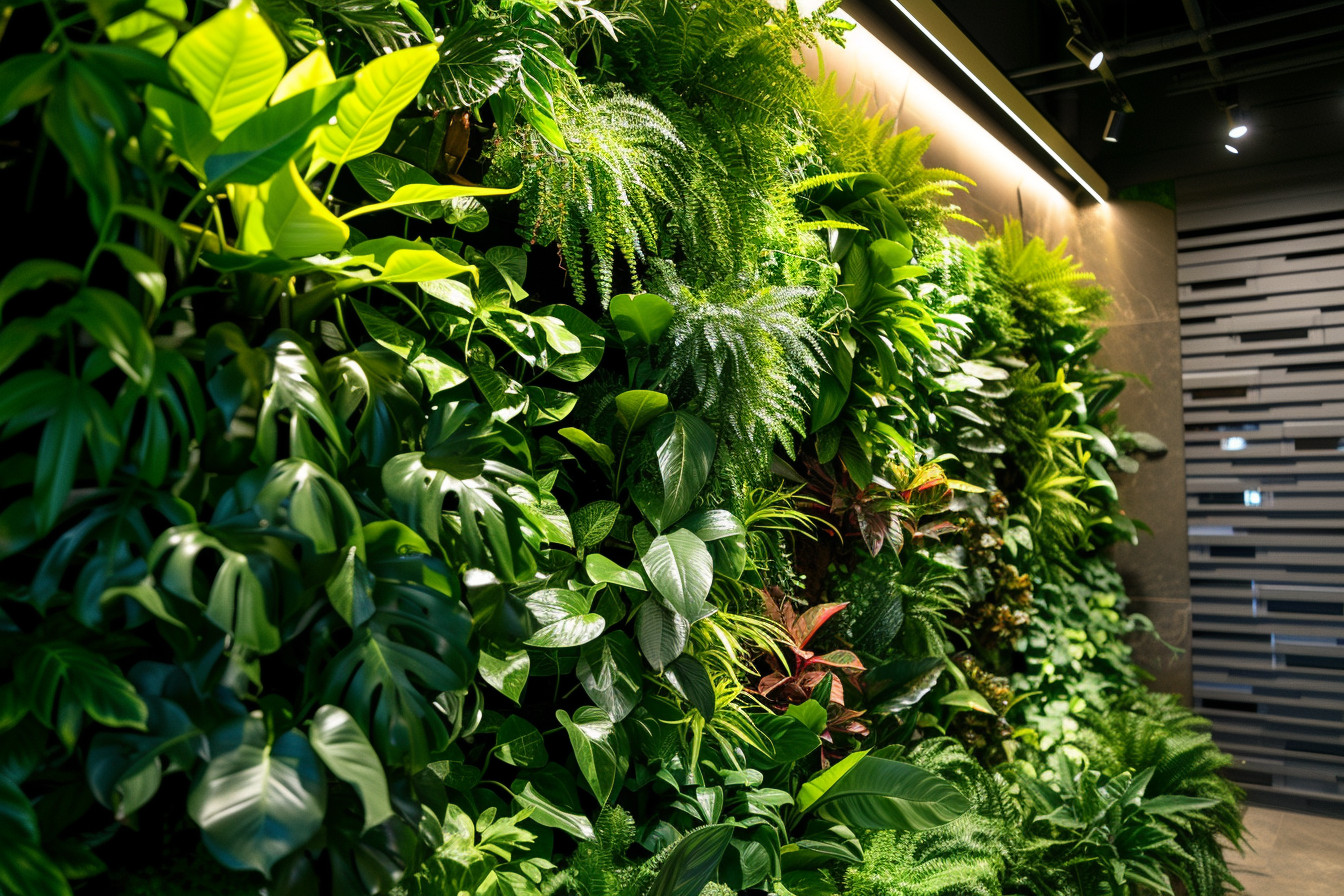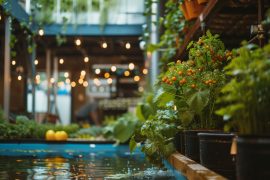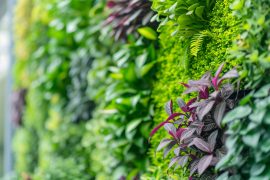Optimizing lighting for indoor vertical gardens is a bit like finding the sweet spot in your favorite comfy chair. It might take some adjusting, but once you get it right, everything feels just perfect. I’ve spent countless hours tinkering with my own setup at home, and let me tell you’, when your plants thrive because they’re getting exactly what they need—well, that’s where the magic happens.
Lighting isn’t just about making sure our green buddies can photosynthesize; it’s an art form that balances intensity, duration, and even the color spectrum to suit different types of plants. The goal? Mimic natural sunlight as closely as possible or tailor light conditions for optimal growth.
The journey toward this balance has taught me so much, not only about gardening but also about patience and attention to detail. Each plant type—from leafy greens to flowering beauties—demands its own unique cocktail of light ingredients if we want them to reach their fullest potential indoors without basking under the sun 24/7, which honestly sounds pretty nice if you ask me.
Benefits of Indoor Vertical Gardens
Indoor vertical gardens are a sight to behold, transforming bland spaces into living, breathing pieces of art. But it’s not just about aesthetics; these gardens bring along a bounty of benefits that touch on environmental efficiency and personal well-being in ways you might not expect.
For starters, they’re phenomenal space-savers. For those of us squeezed into tiny apartments or working within limited areas, going vertical is like finding an extra room you didn’t know existed. By stacking plants upwards rather than spreading them outwards, we maximize greenery without sacrificing precious floor space—a game-changer for urban dwellers yearning for some connection with nature.
Speaking of connections with nature, there’s something undeniably therapeutic about tending to a garden, no matter its size or location. In indoor settings, especially, the act becomes an intimate interaction between humans and plants. It invites calmness, slows down our often hectic pace, and gently reminds us of life outside of digital screens.
Through tactile engagement—be it watering, pruning, or simply observing—we draw closer to earthy realities, cultivating mental health alongside verdant growth.
From an educational standpoint, these setups are goldmines. Digging (both literally and figuratively) into gardening teaches valuable lessons on patience, responsibility, and ecosystem interactions. What starts as curiosity can bloom into genuine expertise over time. Plus, when kids get involved, oh, what joyful messes become opportunities!
They learn life cycles and see firsthand photosynthesis action, all while developing respect for and appreciation of the natural world. Who knows, maybe sparking future botanists, agronomists, and conservationists processes?
Importance of Lighting in Indoor Vertical Gardens
Let’s talk about why lighting is pretty much the lifeblood of indoor vertical gardens. It’s like giving your plants a cozy sunbath that they absolutely love and thrive in. Without proper lighting, our green buddies struggle to perform photosynthesis—their food-making process—and this could lead them down a path we don’t want them going down.
Diving into specifics, it turns out different plants crave different types of light waves for optimum growth: from reds improving flowering processes to blues enhancing foliage development—it reads almost like a fine dining menu catered specifically towards plant preferences!
Here are some cool examples:
**Lettuce** grows best under mixed blue and red LED lights.
**Strawberries**: Yep,you guessed right—more sweetness with those same colors!
Types of Lighting for Indoor Vertical Gardens
Venturing into the world of indoor vertical gardens, it becomes quickly apparent that lighting is not just an element; it’s a backbone. Traditional sunshine doesn’t always reach our beloved indoor plants. Hence, we turn to man-made solutions to mimic those golden rays.
First up in our arsenal are LED lights. They’re like the cool kids on the block due to their energy efficiency and longevity. What’s intriguing about LEDs is that they emit light in specific spectrums, which means you can kind of custom-tailor your light recipe according to what your greens crave! And guess what? Some recent studies suggest that certain wavelengths can even boost plant growth and nutrient content—how neat is that?
Then there’s high-intensity discharge (HID) lamps comprising mostly metal halide (MH) and high-pressure sodium (HPS). MHs throw off a cooler spectrum, great for leafy veggies wanting rapid growth without getting too leggy; HPS leans warmer, ideal for fruits or flowering beauties needing a hefty photosynthesis punch during blooming stages. It’s sort of like summer versus autumn vibes, but indoors.
We also shouldn’t overlook fluorescent bulbs—especially T5 models known for slenderness and mightiness—when fostering young seedlings with tender care by delivering adequate brightness minus the intense heat their HID counterparts might unleash, thus safeguarding sprouts from becoming accidental toasties.
Factors to Consider When Choosing Lighting for Indoor Vertical Gardens
Lighting plays a pivotal role in the health and growth of plants in indoor vertical gardens. Navigating through the world of artificial lighting can be overwhelming, but worry not! Let’s dive into some key factors that will illuminate your path.
First off, let’s talk about light intensity. You might think more is better—like turning up the volume on your favorite song—but it’s all about balance. Different plants have different needs; leafy greens often thrive under moderate intensity, while fruit-bearing plants usually demand more juice. But here’s where it gets fun: playing with LED lights allows you to customize light levels, creating an optimal environment without wasting energy or overpowering your green buddies.
Next up is color temperature—a concept as cool as it sounds. Imagine painting with all shades, from sunrise yellows to deep ocean blues—all these colors influence plant behavior differently! Blue hues encourage vegetative growth, making them stellar during the early development stages, whereas reds are fantastic cheerleaders for flowering and fruit production phases.
Now don’t forget timing: just like us humans crave routine (coffee at 7 AM sharp, anyone?), do our photosynthesizing friends need consistency via photoperiodicity—or, simply put, regular periods of daylight exposure balanced by soothing nights’ rest? This isn’t merely setting up timers; it implies understanding natural cycles, syncing every watt of warmth, nightfall mimicry, and crucial successful gardening adventures indoors.
Tips for Optimizing Lighting in Indoor Vertical Gardens
Embarking on the journey of indoor vertical gardening feels like unlocking a secret realm right inside our homes. One that brings us closer to nature’s calm while painting strokes of green across urban landscapes. Let me dive straight into some golden tips about optimizing lighting, because, frankly, light is everything your garden’s going to thank you for.
First off, selecting the right type of lights can make or break your leafy friends’ lives at home with you. For starters, LED grow lights are all the rage, and understandably so! They’re energy-efficient beasts dishing out an array-packed spectrum, perfect not just for growth but budding happiness as well amongst plants. Picture this: they mimic sunlight without making Texas heat waves jealous; isn’t tech cool?
But hey, don’t just slap them up anywhere; positioning counts big time! Think strategic placement where every plant kid gets its fair share under those luminary lifelines evenly spread across layers—no shade thrown (pun intended!). A neat trick? Angle ’em slightly to ensure even distribution among both high riders and ground-huggers alike, since we know favoritism doesn’t sit well in Garden Eden!
Now, how long should these glowing guardians be on duty? This ain’t 24/7 Vegas Strip—too much love from artificial sun gods might leave ’em overwhelmed, leading to bleached leaves and stunted vibes rather than thriving lushness, which honestly breaks any gardener’s heart, I reckon… Stick around “16 hours” give or take depending upon what beauties reside within, ensuring nighttime silence helps simulate natural cycles essential—rejuvenating their spirits wholesomely till dawn calls again.
Final Thought
This is the wrap-up of our journey through optimizing lighting for indoor vertical gardens. I’ve taken you from understanding why light matters so deeply to these lush, green towers right in your living room or workspace—and hopefully, it’s been as enlightening for you as it was fun for me.
First off, we dived into choosing the perfect lights. Remember that LEDs are a game-changer here—not only are they energy-efficient, but their long lifespan means less hassle replacing them down the line. The choice between full-spectrum and targeted wavelengths? It really boils down to what plants you’re cozying up with. Some like a broad range, while others thrive under specific colors.
Then there’s adjusting intensity and duration—this bit gets technical, but stick with me! Your veggies want different amounts of sunlight at each growth stage; mimic this indoors by tweaking how bright those bulbs shine and how long they stay lit each day.
Do remember hydration, though—it’s easy to overlook water when talking about light, but trust me, every leafy friend will thank you more if balance reigns supreme in their world!
A neat thing happened during my dive into artificial lighting: My deep appreciation grew not just for scientific advancements enabling us to rear nature indoors but also for realizing yet again how essential patience, compassion, and reflection still stand even amidst all the innovations technology brings.







